-
Paper Information
- Paper Submission
-
Journal Information
- About This Journal
- Editorial Board
- Current Issue
- Archive
- Author Guidelines
- Contact Us
Computer Science and Engineering
p-ISSN: 2163-1484 e-ISSN: 2163-1492
2021; 11(1): 17-21
doi:10.5923/j.computer.20211101.03
Received: May 19, 2021; Accepted: May 31, 2021; Published: Jun. 15, 2021

Solution of Poisson’s Equation Using Artificial Neural Networks
Jay P. Narain
Retired, Worked at Lockheed Martin Corporation, Sunnyvale, CA, USA
Correspondence to: Jay P. Narain , Retired, Worked at Lockheed Martin Corporation, Sunnyvale, CA, USA.
| Email: |  |
Copyright © 2021 The Author(s). Published by Scientific & Academic Publishing.
This work is licensed under the Creative Commons Attribution International License (CC BY).
http://creativecommons.org/licenses/by/4.0/

The solution of Partial differential equations has been of considerable interest lately because of interest in Machine Learning methods. The use of artificial neural network to solve ordinary and partial differential equations has been elaborately described in the works of Lagaris, Likas and Fotiadis [1]. Although finite difference, finite element, and other numerical and analytical methods are computationally more efficient, the machine learning methods like artificial neural network offer the hope of solving complicated non-linear equations without deriving analytical methods. The neural network method [1] uses boundary conditions embedded with neural network. Some neural network experience is required to use such method. Presently a very simple neural network scheme is presented where boundary conditions are explicitly applied in the loss function. The neural network differentiation method is based on the work of Luis Angel [2].
Keywords: Differential equations, Ordinary and partial, Neural netwok, Network differentiation, Machine learning methods
Cite this paper: Jay P. Narain , Solution of Poisson’s Equation Using Artificial Neural Networks, Computer Science and Engineering, Vol. 11 No. 1, 2021, pp. 17-21. doi: 10.5923/j.computer.20211101.03.
1. Introduction
- The ordinary and partial differential equations have been solved anaytically and numerically for many years. Various numerical schemes were developed with the advent of computers. From such schemes, the finite difference scheme has been a popular numerical method. Findiff library from PyPl offers a Python package to solve such equations in any number of dimensions [3]. The boundary condition based neural network method for non linear Blasius equation using autogad library [4] was investigated by Kitchin [5]. This work was extended to more complicated Falkar-Skan equations by Narain [6]. The neural network schemes require derivative of neural network. The autograd library [4] was used in these methods for equations in one dimension. The present work is aimed at solving Poisson’s equation in two dimensions. This equation is used in many engineering fields such as fluid dynamics, electrostatics, traffic control system, etc. Angel [2] has developed a nice scheme for multi -dimensional neural network and their derivatives. With this scheme, any ordinary and partial differential equation can be solved with ease. Most of the applications have been for Laplace equation which is Poisson’s equation with no source term. Several examples for Poisson’s equation will be presented together with comparison with finite difference scheme.
2. Discussions
- Poisson’s equation is𝛥𝛟 = fwhere 𝛥 is the Laplace operator, and f and 𝛟 are real or complex valued functions on a manifold. Usually, the source function f is given and 𝛟 is sought. When the manifold is Euclidean space, the Laplace operator is often denoted as 𝛻2 and so Poisson’s equation is frequently written as𝛻2 𝛟 = fIn two-dimensional cartesian coordinates, it takes the formd2 𝛟(x,y)/dx2 + d2 𝛟(x,y)/dy2 = f(x,y)when f =0, we obtain Laplace’s equation. cartesian coordinates.To solve any equation, boundary conditions are needed. There are three type of boundary conditions (b.c.), for example boundary condition on edge y=0 would be𝛟(x,0) = a(x)which is the Dirichlet Boundary condition, andd 𝛟(x,0)/dn = b(x)which is Neumann boundary condition. A mixture of Dirichlet and Neumann is termed as mixed boundary condition. dn denoted normal direction on an edge.There are several ways, this equation can be solved. Exact solution can be obtained using Green's function and other methods. Very fast and accurate numerical solution can be obtained using finite difference, finite volume, finite element and other methods. The matrix inversion methods are efficient for small dimensions, Jacobi and Gauss-Seidel iterative methods are good for any dimension and any boundary condition. The gradient decent and conjugate gradient methods are more efficient but are limited to zero Dirichlet boundary conditions on the edges.Following ref 2., the neural network for a two-dimensional case is defined asDefine neural_network(x,W) as nnet:
 The important neural net derivative function is defined as
The important neural net derivative function is defined as Here x is the input vector with two coordinates (x,y), W is the network weight and b is the bias, j denoted direction of partial derivatives (0 for x, 1 for y), and k stands for partial derivative order ((1 for first order, 2 for second order).The loss function is defined as
Here x is the input vector with two coordinates (x,y), W is the network weight and b is the bias, j denoted direction of partial derivatives (0 for x, 1 for y), and k stands for partial derivative order ((1 for first order, 2 for second order).The loss function is defined as Where
Where  is the summation indicator for all the boundary condition errors. An example of b.c error will be 𝛟(x,0) - a(x).Next the gradient of the loss_sum is minimized by Adam scheme [4]. In general, the nnet function is initialized with random numbers. Thus, the initial solution will look totally different from expected solution. After five hundred iterations, the solution converges. The predicted solution matches pretty well with the FinDiff or exact solution.Next we will examine two cases from ref. 1. One has Dirichlet boundary condition. Other one can be solved both in Dirichlet b.c. mode or as a mixed b.c. mode. We shall use mixed b.c. mode as it will show the ease of problem setup for such case.The complete Python program for this paper can be downloaded from narain42/Poission-s-Equation-Solver-Using-ML on github.com.
is the summation indicator for all the boundary condition errors. An example of b.c error will be 𝛟(x,0) - a(x).Next the gradient of the loss_sum is minimized by Adam scheme [4]. In general, the nnet function is initialized with random numbers. Thus, the initial solution will look totally different from expected solution. After five hundred iterations, the solution converges. The predicted solution matches pretty well with the FinDiff or exact solution.Next we will examine two cases from ref. 1. One has Dirichlet boundary condition. Other one can be solved both in Dirichlet b.c. mode or as a mixed b.c. mode. We shall use mixed b.c. mode as it will show the ease of problem setup for such case.The complete Python program for this paper can be downloaded from narain42/Poission-s-Equation-Solver-Using-ML on github.com.3. Examples
- The first example, Problem 7 of ref. 1, is a very simple case with zero Dirichlet b.c. on three edges, and a non-zero either Dirichlet or Neumann b.c. on one edge. The following are the details:𝛻2 𝛟 (x, y) = (2. – π2y2) sin(πx)with x, y ϵ [0,1] and with mixed b.c, 𝛟 (0, y) = 0, 𝛟 (1, y) = 0, 𝛟 (x,0) = 0, and d 𝛟(x, 1)/dy = 2 sin(πx).First the FinDiff , finite-difference solution is obtained. The solution plots are shown below.
 | Figure 1(a). Exact solution |
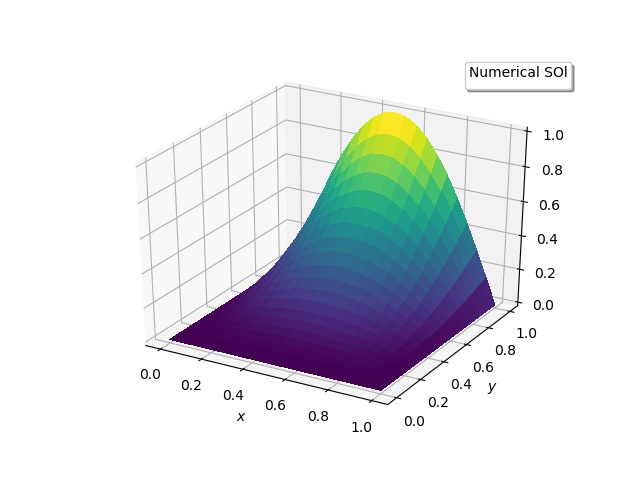 | Figure 1(b). Numerical Solution |
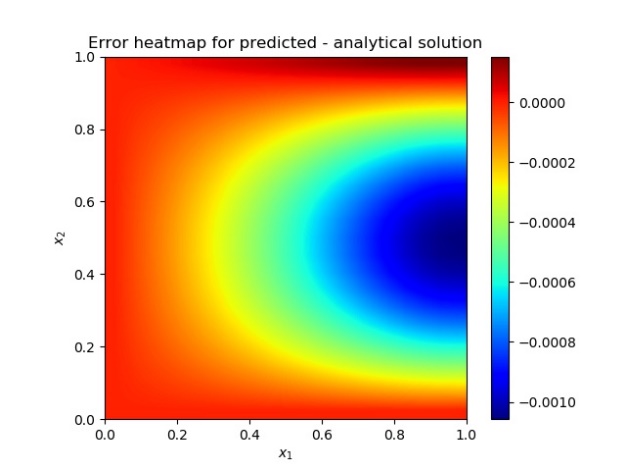 | Figure 1(c). Error between solutions |
 This is all what is required to do the Adam [4] optimization to get the desired solution. The results are:
This is all what is required to do the Adam [4] optimization to get the desired solution. The results are: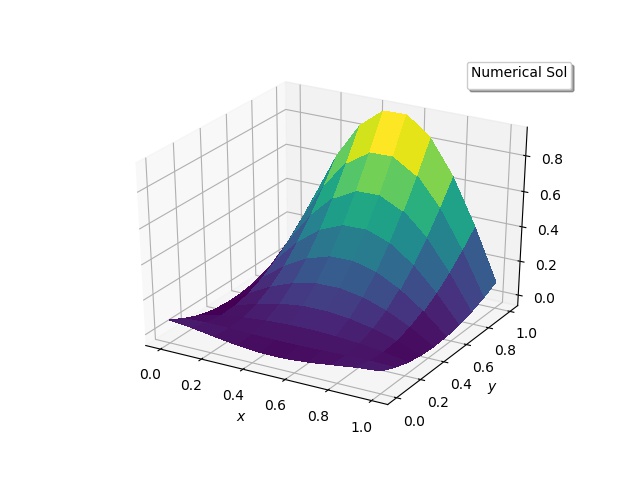 | Figure 2(a). Numerical solutions |
 | Figure 2(b). heatmap of the solution error |
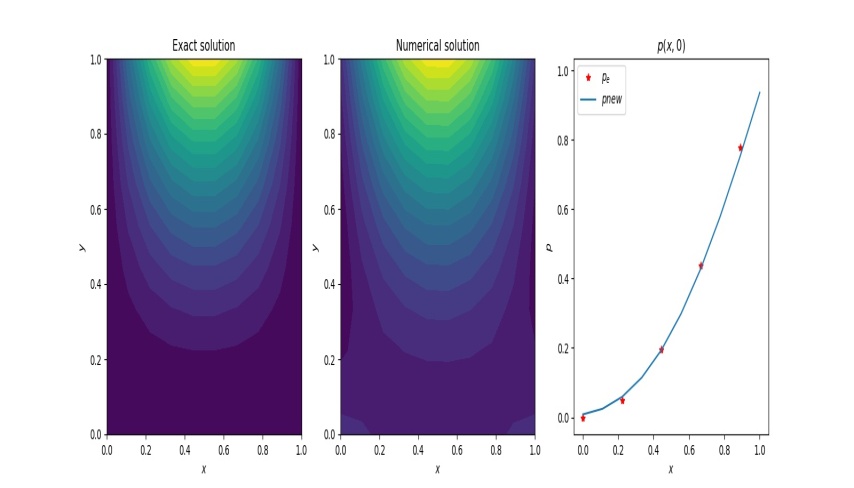 | Figure 2(c). Contour plots and comparison with exact solution |
 This model is used in Adam [4] optimization to get the desired solution. The Dirichlet b.c. problems converge faster than Neumann conditions. It took only 580 seconds on a (15x15) grid, with 5000 iterations, to converge. No FinDiff results are presented to save the length of this article. The results are similar to those presented below.
This model is used in Adam [4] optimization to get the desired solution. The Dirichlet b.c. problems converge faster than Neumann conditions. It took only 580 seconds on a (15x15) grid, with 5000 iterations, to converge. No FinDiff results are presented to save the length of this article. The results are similar to those presented below. | Figure 3(a). Contour plots and comparison with exact solution |
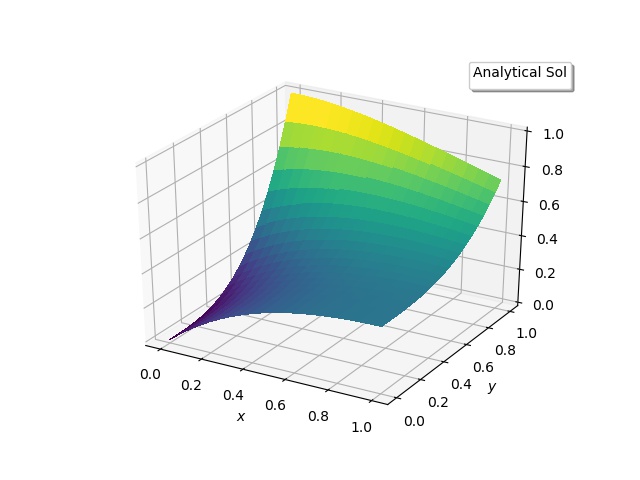 | Figure 3(b). Exact solution |
 | Figure 3(c). Numerical solution |
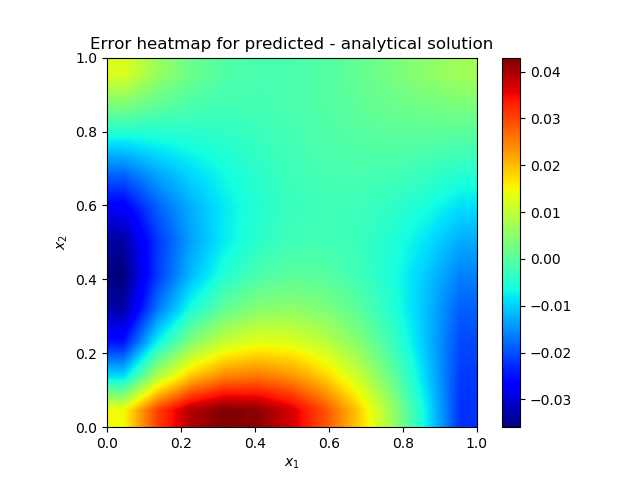 | Figure 3(d). Heatmap of the solution error |
4. Conclusions
- The new neural network scheme seems to be an efficient way to solve partial differential equations up to second order. The method was applied to first order linear and non-linear partial differential equation cases. Although the results are not reported to keep this paper concise, the results were precisely similar to FinDiff solutions.
 Abstract
Abstract Reference
Reference Full-Text PDF
Full-Text PDF Full-text HTML
Full-text HTML